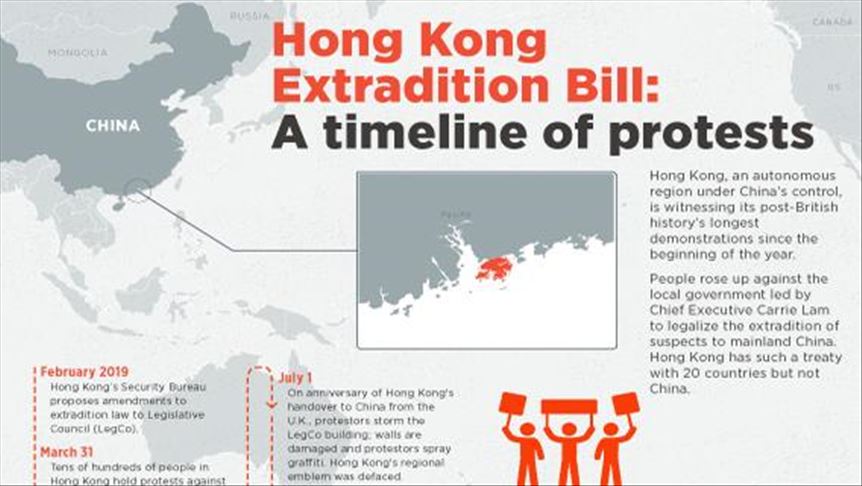Hong Kong extradition bill: A timeline of protests
Bill withdrawn on Sept. 4 but protesters want Chief Executive Carrie Lam to meet other demands

ANKARA
Since the beginning of the year Hong Kong, a semi-autonomous region under China’s control, has witnessed its largest and longest-lasting demonstrations since British sovereignty over the territory ended in 1997.
People rose up against the efforts by the local government led by Chief Executive Carrie Lam to legalize the extradition of suspects to mainland China. Hong Kong has such agreements with 20 countries, but not with China.
The proposal raised public tensions in the world’s busiest business hub.
The bill to amend the extradition law was finally withdrawn on Sept. 4, but people are still upset and want Lam to meet other demands.
February 2019: Hong Kong’s Security Bureau proposes to legislature changes to extradition law.
March 31: Tens of hundreds of people in Hong Kong hold protests against the proposed extradition bill.
April 3: Lam's government accepts and formally introduces changes to the extradition law that would allow criminal suspects to be sent to mainland China for trial.
Move triggers concerns that the change, if passed, would put the accused at the mercy of Chinese courts
May 11: Brawl breaks out in Hong Kong’s legislature between pro-democracy lawmakers and those loyal to Beijing.
May 21: Lam maintains her government will push the bill through the legislative process.
May 30: Protests force administration to introduce concessions to the proposed bill to limit the scope of extraditable offenses.
June 4: Petition against the extradition law is signed by over 120,000 students, alumni, staff, and parents from 185 secondary schools, while hundreds attend the annual vigil for 1989 Tiananmen Square massacre victims.
June 6: Dressed in black, 3,000 Hong Kong lawyers take to the streets to protest extradition law.
June 9: An estimated 1 million people march in one of the biggest protests to date. It was largely peaceful.
June 12: Hong Kong police fire rubber bullets and tear gas on protestors in fresh demonstrations.
June 15: Lam gives in, indefinitely postpones the reading of the proposed bill to change extradition law.
July 1: On the anniversary of Hong Kong's handover to China from the U.K., protestors storm legislature building; walls are damaged and protestors spray graffiti. Hong Kong's regional emblem defaced.
July 9: ‘The proposal to amend extradition bill is dead,’ announces Lam.
July 21: Protesters deface China's Liaison Office in Hong Kong while unknown men, clad in white T-shirts and some armed with poles, flood rural Yuen Long station, storming into a train.
Passengers, passers-by -- including members of the media -- are attacked
July 24: Protesters disrupt metro services while China's Defense Ministry announces troops stationed in Hong Kong can intervene to help maintain public order, if necessary.
Aug. 2: Thousands of civil servants, supposedly politically neutral, join demonstrations.
Aug. 3: Protests take place for the ninth consecutive weekend.
Aug. 4: Protests take place across the region with demonstrators calling for a mass strike the next day. Lam invites student leaders to a meeting.
Aug. 5: People observe a general strike with civil servants walking out and joining protests. Violence escalates as police use tear gas and rubber bullets to clear crowds, as large bonfires are set outside police stations around Hong Kong.
Protests derail more than 200 flights in and out of Hong Kong. Nearly 148 protesters arrested while 800 tear gas rounds fired by police.
Student leaders make meeting with Lam conditional
Aug. 12: Protesters gather at Hong Kong’s international airport, and hundreds of flights are canceled.
Aug. 14: Clashes between police and protesters erupt at the airport after flights are disrupted for a second day.
Aug. 19: Reports emerge that several Hong Kong protestors fled to Taiwan, fearing reprisal for protests.
Sept. 2: Lam says she would quit if she had a choice, releases an audio recording of her meeting with a group of businesspeople.
On first day of schools after summer vacation, students boycott classes, seeking complete withdrawal of the bill
Sept. 3: Lam denies reports that she asked the Chinese government to let her resign.
Sept. 4: Lam withdraws the proposal to amend extradition bill, addressing 1 of 5 demands made by protesters.
Protestors' further demands
a) Withdrawal of the word "riot" to describe June 12 protests
b) Amnesty for all arrested protesters
c) Independent inquiry into alleged police brutality
d) Universal suffrage in elections for Hong Kong's chief executive and legislature
Anadolu Agency website contains only a portion of the news stories offered to subscribers in the AA News Broadcasting System (HAS), and in summarized form. Please contact us for subscription options.








